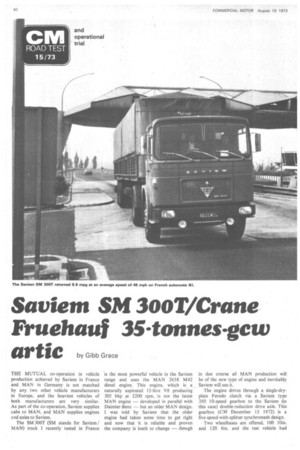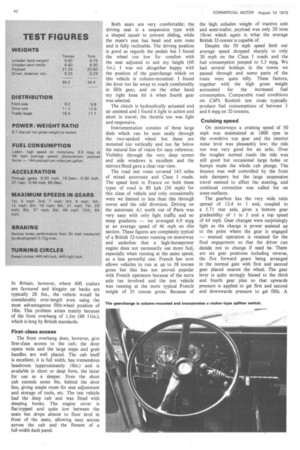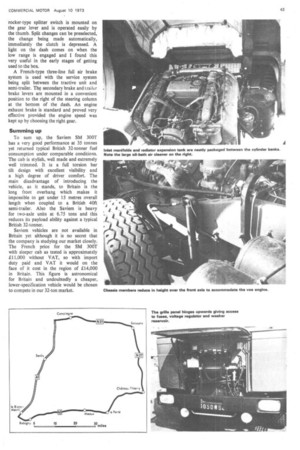Saviem SM 300T/Crane Fruehauf 35-tonnestcw
Page 42

Page 43

Page 44

Page 45

If you've noticed an error in this article please click here to report it so we can fix it.
atone by G bb Grace
THE MUTUAL co-operation in vehicle production achieved by Saviem in France and. MAN in Germany is not matched by any two other vehicle manufacturers in Europe, and the heaviest vehicles of both manufacturers are very similar. As part of the co-operation, Saviem supplies cabs to MAN, and MAN supplies engines and axles to Saviem, The SM 300T (SM stands for Saviem / MAN) truck I recently tested in France is the most powerful vehicle in the Saviem range and uses the MAN 2658 M42 diesel engine. This engine, which is a naturally aspirated 15-litre V8 producing 305 bhp at 2200 rpm, is not the latest MAN engine — developed in parallel with Daimler-Benz but an older MAN design. I was told by Saviem that the older engine had taken some time to get right and now that it is reliable and proven the company is loath to change — though in due course all MAN production will be of the new type of engine and inevitably Saviem will use it,
The engine drives through a single-dryplate Ferodo clutch via a Saviem type 350 10-speed gearbox to the Saviem On this case) double-reduction drive axle. This gearbox (CM December 15 1972) is a five-speed-with-splitter synchromesh design.
Two wheelbases are offered, 10ft 10in. and 12ft 6in. and the test vehicle had the shorter one and was coupled to a Crane Fruehauf 11.9-metre (3911 lin.) long TIR tilt semi-trailer. Using a 14in. fifth-wheel offset and a typical Continental 1.5-metre (4ft I lin.) kingpin set back on the trailer, the whole unit measured a few inches less than 15 metres overall. In Britain, however, where 40ft trailers are favoured and kingpin set backs are typically 2ft Sin., the vehicle would be considerably over-length even using the most advantageous fifth-wheel position of 18in. This problem arises mainly because of the front overhang of 1.5m (4ft I lin.), which is long by British standards.
First-class access
The front overhang does, however, give first-class access to the cab; the door opens wide and the large steps and grab handles are well placed. The cab itself is excellent; it is full width, has tremendous headroom (approximately 18in.) and is available in short or deep form, the latter for use as a sleeper. Even the short cab extends some 9in. behind the door line, giving ample room for seat adjustment and storage of tools, etc. The test vehicle had the deep cab and was fitted with sleeping bunks. The engine cover is flat-topped and quite low between the seats but drops almost to floor level in front of the seats, allowing easy access across the cab and the fitment of a full-width dash panel. Both seats are very comfortable; the, driving seat is a suspension type with a shaped squab to prevent sliding, while the mate's seat has head and arm rests and is fully reclin able. The driving position is good as regards the pedals but I found the wheel too low for comfort with the seat adjusted to suit my height (6ft lin.). I was not altogether happy with the position of the gearchange which on this vehicle is column-mounted: I found the lever too far away to reach comfortably in fifth gear, and on the other hand my right knee hit it when fourth gear was selected.
The clutch is hydraulically actuated and air assisted and I found it light in action and short in travel; the throttle too was light and responsive.
Instrumentation consists of three large dials which can be seen easily through the two-spoked wheel but these are mounted too vertically and too far below the natural line of vision for easy reference. Visibility through the very deep screen and side windows is excellent and the mirrors fitted gave a clear rear view.
The road test route covered 143 miles of mixed autoroute and Class I roads. The speed limit in France on both these types of road is 80 kph (50 mph) for this class of vehicle and only occasionally were we limited to less than this through towns and the odd diversion. Driving on the autoroute Al north out of Paris was very easy with only light traffic and no steep gradients — we averaged 6.9 mpg at an average speed of 46 mph on this section. These figures are completely typical of a British 32-tonner running on motorway and underline that a high-horsepower engine does not necessarily use more fuel, especially when running at the same speed, as a less powerful one. French law now allows vehicles to run at up to 38 tonnes gross but this has not proved popular with French operators because of the extra axle tax involved and the test vehicle was running at the more typical French weight of 35 tonnes gross. Because of the high unladen weight of tractive unit and semi-trailer, payload was only 20 tons 18cwt which again is what the average British 32-tonner is capable of.
Despite the 50 mph speed limit our average speed dropped sharply to only 30 mph on the Class I roads and the fuel consumption jumped to 5.5 mpg. We had several holdups in the towns we passed through and some parts of the route were quite hilly. These factors, together with the high gross weight accounted for the increased fuel consumption. Comparable road conditions on CM's Scottish test route typically produce fuel consumptions of between 5 and 6 mpg on 32-tonners.
Cruising speed
On motorways a cruising speed of 50 mph was maintained at 1800 rpm in the overdrive top gear and the interior noise level was pleasantly low; the ride too was very good for an artic. Over the rougher normal roads the ride was still good but occasional large holes or bumps made the whole cab plunge. The bounce was well controlled by the front axle dampers but the large suspension travel seemed to affect the steering, and continual correction was called for on some surfaces.
The gearbox has the very wide ratio spread of 12.4 to 1 and, coupled to a 5.71 rear axle, gives a bottom gear gradeability of 1 in 5 and a top speed of 64 mph. Gear changes were surprisingly light as the change is power assisted up to the point where the gear is engaged — manual operation is retained for the final engagement so that the driver can decide not to change if need be. There are six gear positions including reverse, the five forward gears being arranged in the normal gate with first and second gear placed nearest thefl wheel. The gear lever is quite strongly biased to the third and fourth gear plan so that upwards pressure is applied to get first and second and downwards pressure to get fifth. A rocker-type splitter switch is mounted on the gear lever and is operated easily by the thumb. Split changes can be preselected, the change being made automatically, immediately the clutch is depressed. A light on the dash comes on when the low range is engaged and I found this very useful in the early stages of getting used to the box.
A French-type three-line full air brake system is used with the service system being split between the tractive unit and semi-trailer. The secondary brake and trai ler brake levers are mounted in a convenient position to the right of the steering column at the bottom of the dash. An engine exhaust brake is standard and proved very effective provided the engine speed was kept up by choosing the right gear.
Summing up To sum up, the Saviem SM 300T has a very good performance at 35 tonnes yet returned typical British 32-tonner fuel consumption under comparable conditions. The cab is stylish, well made and extremely well trimmed. It is a full torsion bar tilt design with excellent visibility and a high degree of driver comfort. The main disadvantage of introducing the vehicle, as it stands, to Britain is the long front overhang which makes it impossible to get under 15 metres overall length when coupled to a British 40ft semi-trailer. Also the Saviem is heavy for two-axle units at 6.75 tons and this reduces its payload ability against a typical British 32-tonner.
Saviem vehicles are not available in Britain yet although it is no secret that the company is studying our market closely. The French price for the SM 300T with sleeper cab as tested is approximately £11,000 without VAT, so with import duty paid and VAT it would on the face of it cost in the region of £.14,000 in Britain. This figure is astronomical for Britain and undoubtedly a cheaper, lower-specification vehicle would be chosen to compete in our 32-ton market.




























































































